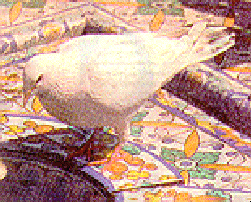|
In a variety
of settings we encounter pigeons searching for food concealed among  assorted inedible objects. Efficient foraging requires appropriate perceptual
and cognitive strategies, and certain of those adopted by pigeons resemble
selective processes employed by humans in laboratory detection tasks.
For example, the birds are more likely to consume grains that are dissimilar
to the background. Further, pigeons overselect grain types that are relatively
abundant, an observation that suggests that they focus their attention
on more probable targets. The structure
of their visual systems is well-suited to the search task; For example,
specialized retinal areas serve their lower field of view, and a flexible
accommodation mechanism allows them to focus on close objects.
assorted inedible objects. Efficient foraging requires appropriate perceptual
and cognitive strategies, and certain of those adopted by pigeons resemble
selective processes employed by humans in laboratory detection tasks.
For example, the birds are more likely to consume grains that are dissimilar
to the background. Further, pigeons overselect grain types that are relatively
abundant, an observation that suggests that they focus their attention
on more probable targets. The structure
of their visual systems is well-suited to the search task; For example,
specialized retinal areas serve their lower field of view, and a flexible
accommodation mechanism allows them to focus on close objects. Research using artificial search displays has
shed light on mechanisms that guide the pigeons' search. These techniques
permit more precise control of important variables such as form similarity.
In our lab birds peck at designated  target letters embedded among non-target
symbols displayed on a computer screen (See Figure
1). Detection is more
efficient, not only for more probable targets, but also when specific cues
inform the bird of the forthcoming target's identity. Like humans, pigeons
search more rapidly for expected items, and they can use varied types of
information to form such expectancies. These associations are acquired
in a manner that seems to depart from the usual rules of conditioning. target letters embedded among non-target
symbols displayed on a computer screen (See Figure
1). Detection is more
efficient, not only for more probable targets, but also when specific cues
inform the bird of the forthcoming target's identity. Like humans, pigeons
search more rapidly for expected items, and they can use varied types of
information to form such expectancies. These associations are acquired
in a manner that seems to depart from the usual rules of conditioning. |

